Town of Manitowish
Introduction
Text-to-speech Audio
In 1889, the Chicago Northwestern Railroad tracks crossed the Manitowish River and established a modest rail stop. By 1890, loggers, trappers, guides, sportsmen and pioneers rushed to the Manitowish rail stop as a launching point into the mostly untouched Northwoods wilderness. The rail stop at Manitowish grew quickly and had a hotel and store by 1890. Early on, the town of Manitowish was a regional hub for transportation until about 1905 when Mercer added a rail line to the towns of Winchester and Winegar (Presque Isle). Population patterns in Manitowish were noted in Wisconsin Gazetteers: 1895 population 50, 1911 population 100, and 1921 population 35. In the 1937, the Works Progress Administration sponsored the recording of Iron County's history, which did not recognize the Town of Manitowish.
Manitowish became the homes of many pioneer families. The Manitowish School was a point of pride for the entire town. Today's Manitowish Waters was strongly coupled to the Town of Manitowish. The Manitowish rail stop was the primary source for supplies that had to be moved over seven miles by wagons or trucks to the Rest Lake Dam and beyond. Tourists most often used the Manitowish rail stop to access Manitowish Waters. Manitowish even provided postal service to Manitowish Waters until 1940. The Manitowish Post Office was discontinued in 1968, and mail then was routed through Mercer.
Today, Manitowish appears to be a crossroads of Highways 47 and 51, but careful examination of history reveals a deep and rich chapter of Northwoods heritage.
Travelers can easily access Manitowish by car, the Mercer Bike Trail, or paddling on the Manitowish River. Property around Manitowish is mostly private, with the exception of The Lazy Ace and Ullman's Ding-A-Ling Supper Club. Private property should be respected by all travelers.
Images
Early 20th Century Plat Maps around the Town of Manitowish
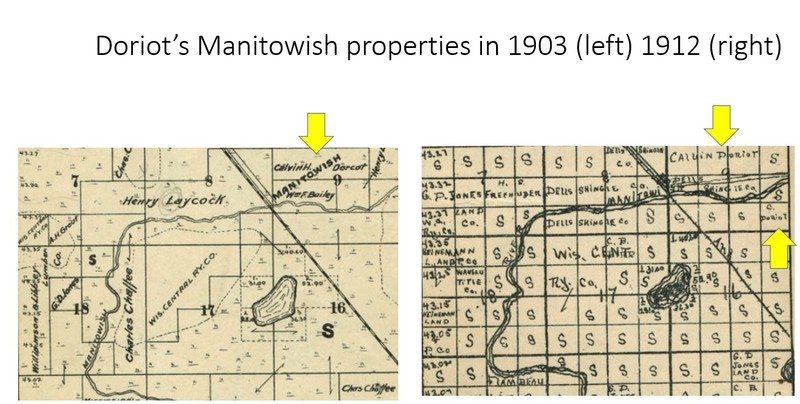
1893 ad for Manitowish Hotel run by Kuss and Fouks
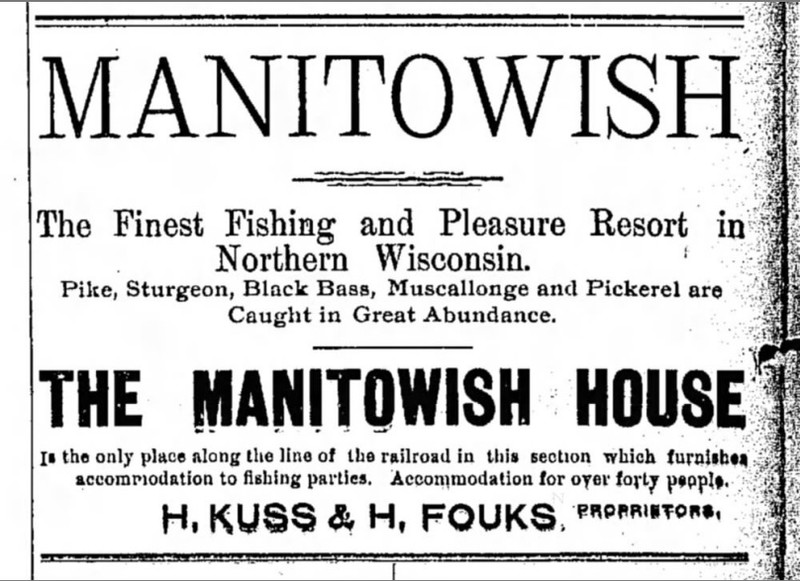
Logging operation in 1893

Manitowish Depot and train
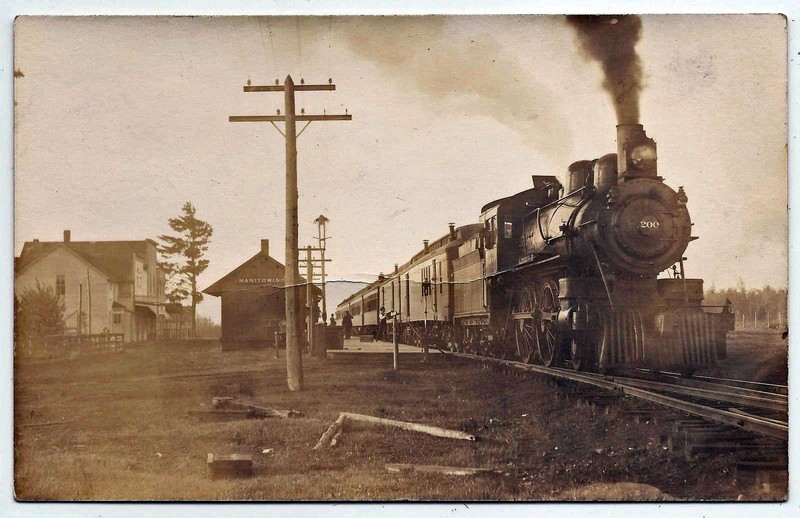
Departing from the train at Manitowish
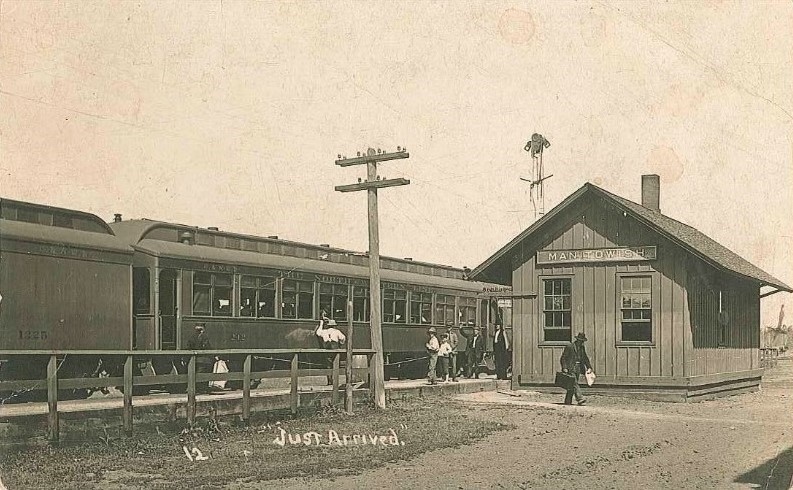
Buck's 1900 map excerpt illustrating a hotel at Manitowish and the 7 and 1/4 mile highlighted route to Rest Lake Dam
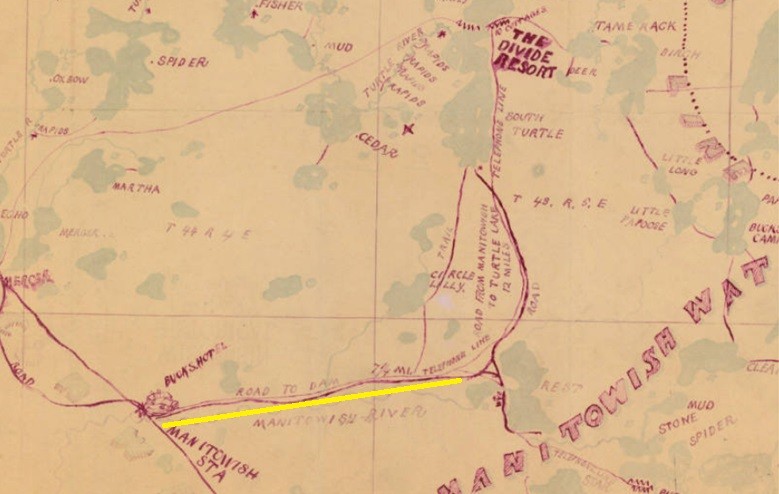
Manitowish Depot with Attendant
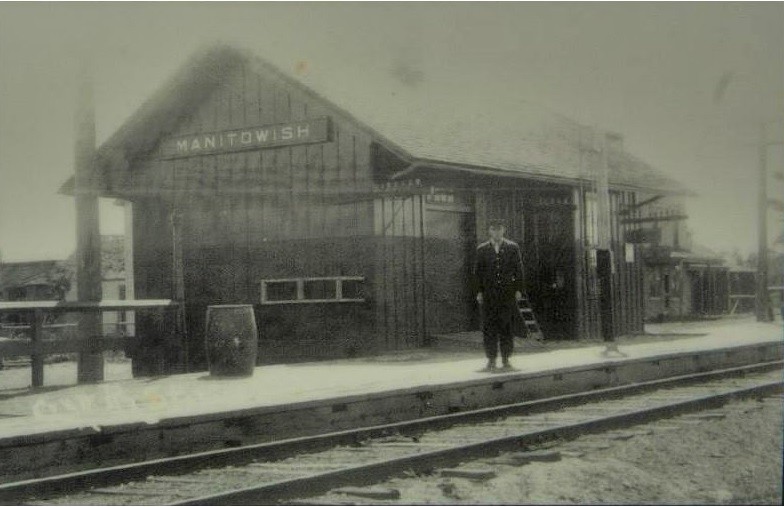
Train at Manitowish and Chuck's Bar

View across the tracks toward Manitowish
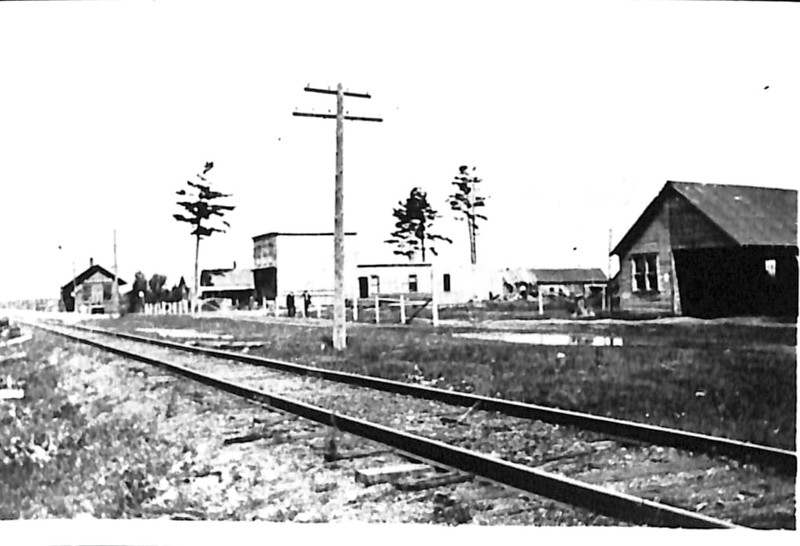
Manitowish Depot in 1920's with Nutter house in the background
.jpg)
Close-up of Manitowish Depot
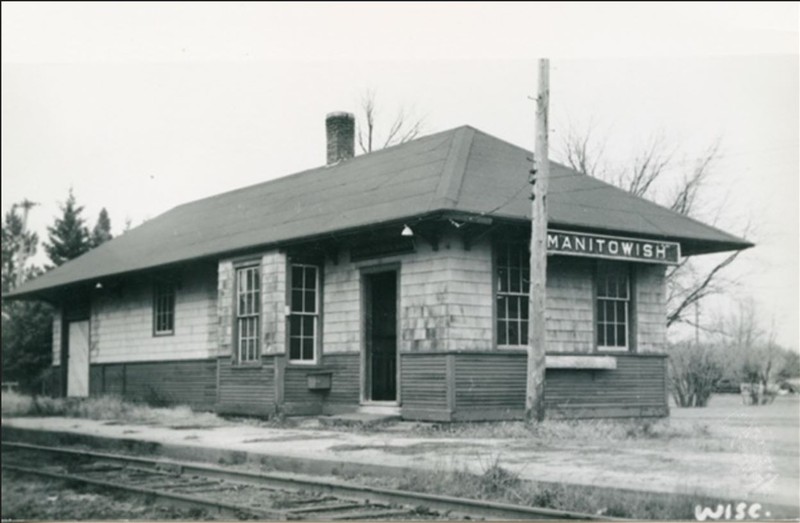
Manitowish School
%20(1).jpg)
Manitowish Post Office
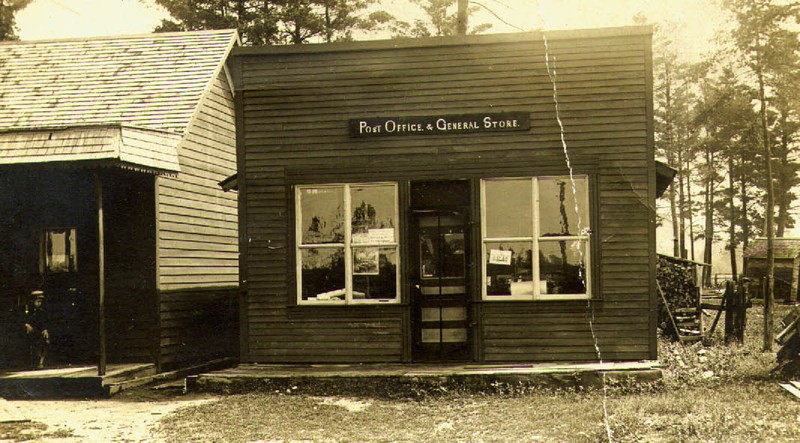
Richard Sleight Sr. establishes subdivided property in Manitowish in 1923, map
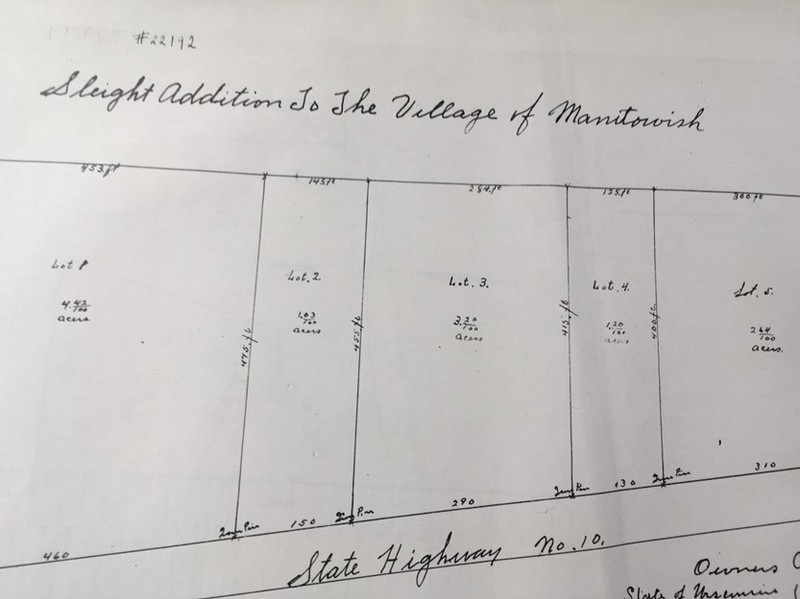
Richard Sleight Sr. establishes subdivided property in Manitowish in 1923, owner's certificate
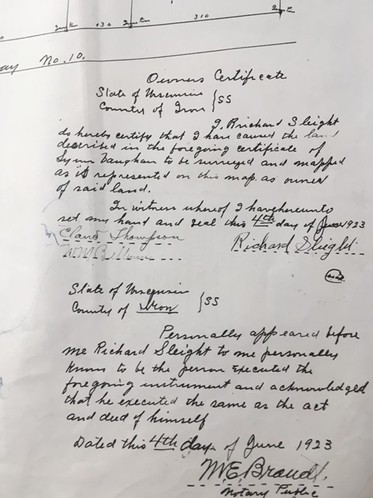
1938 aerial photo of Manitowish Wisconsin
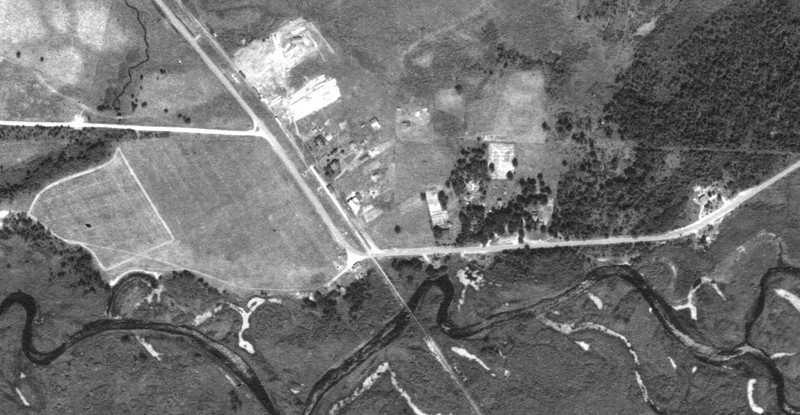
Sleight family loading canoes in the Town of Manitowish; note the railroad bridge and wild rice in the background
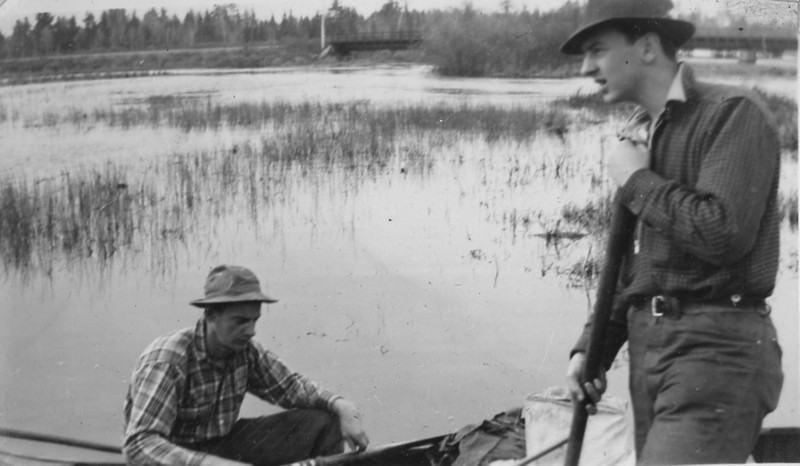
1895 ad for Buck's resorts, illustrating how early railroads boosted tourism in Manitowish Waters and Winchester (Turtle Waters)
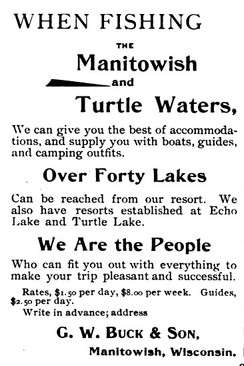
Chicago Northwestern Railroad promoted State Forestry Department lease properties; inexpensive lakefront property drew families to Rest and Vance Lakes
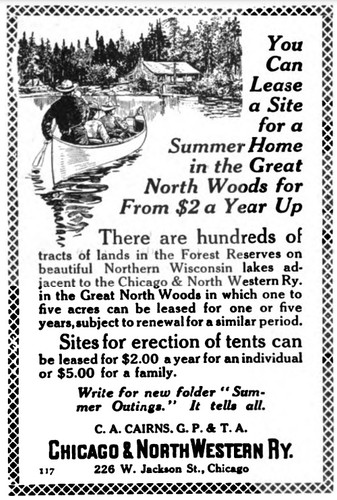
By 1915 auto livery from Manitowish Station marked the beginning of the automobile age; that was also the same year the automobile bridge was built between Spider and Manitowish Lakes.
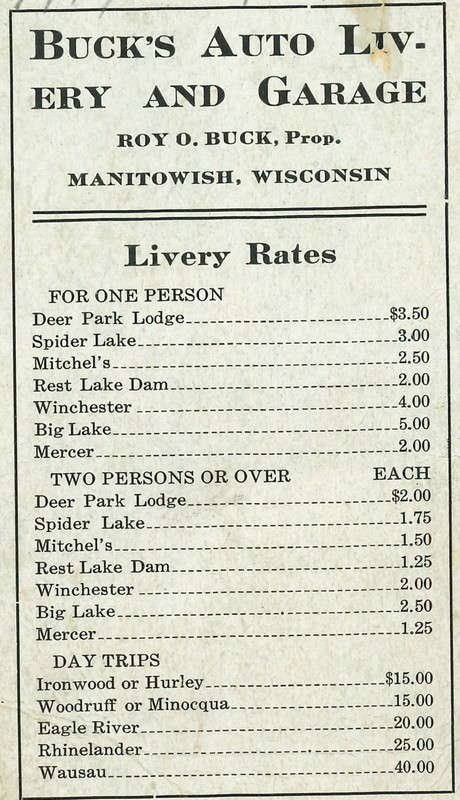
Horse Delays Train. A funny story that gave the town of Manitowish and a train full of travelers a laugh.
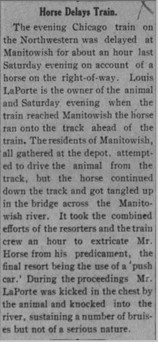
Depot and Manitowish main street
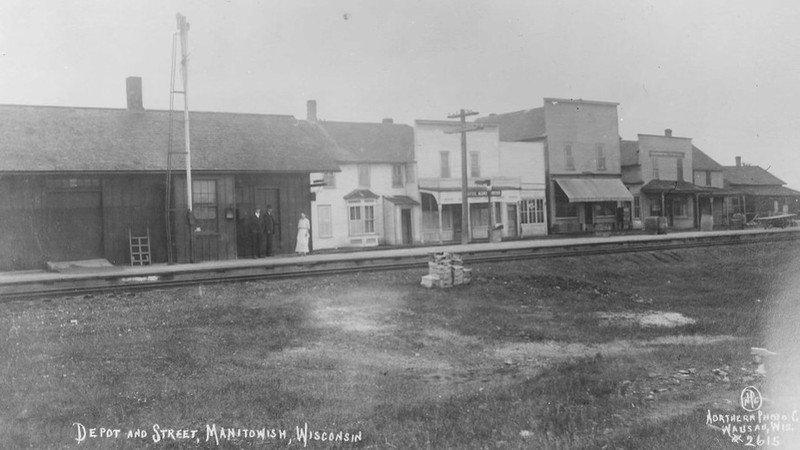
Backstory and Context
Text-to-speech Audio
The Chicago Northwestern Railroad created the town of Manitowish. As a logging boom town, Manitowish grew as commerce spiked. Immediately, tourists wanted to experience the great Wisconsin Northwoods. Loggers, trappers and timber cruisers also acted as guides, connecting clients with trophy fish and game. Resorts sprung up immediately, first as tent camps and later as cabins. It was not long before stylish resorts were the primary destination for not only outdoor adventure seekers but entire families. Rail service to Manitowish slowly began to decline after World War II. Summer trains and Christmas trains continued to be very popular. Historian Michael Dunn recalls that the Christmas trains over the holidays of 1970-1971 marked the end of more than 80 years of rail service to the of Town of Manitowish. In 1983, the old Chicago Northwestern rail line ceased operation.
The community of Manitowish built their first school in 1892. Sadly, it burned down in 1908 and was rebuilt at the same site. The old schoolhouse is still standing and is owned by Russ Sleight, who is related to the first schoolteacher in Manitowish. Long distance telephone service was added to Manitowish in 1914. Automobiles emerged on the Manitowish scene by 1915, with Roy Buck's garage and livery service. An auto livery ride to Mercer, Winchester or Rest Lake Dam cost $2 from Manitowish.
The big business in early Manitowish was logging. Ironically, much of the early logging was river drive white pine and not railroads. Railroads did facilitate the transport of river drive loggers, equipment and animal feed. Animal feed of hay and oats allowed loggers to switch from oxen to horses to move logs to the lakes and rivers for the spring drives. Fredrick Weyerhaeuser and his syndicate of corporations controlled much of the river drive logging on the Manitowish, Flambeau and Chippewa rivers. By 1905, river drive logging of white pine was in decline. Railroads had been moving logs since 1889, but railroad logging expanded dramatically in 1900. As white pine logging declined, railroad logging focused on remaining pines and hardwoods like maple, birch and oak. Railroad logging declined in the 1920s.
In the 1890s, business in the Manitowish were competing with the growing town of Mercer, just three miles to the north. The 1895 Wisconsin State Gazetteer identified early Manitowish business as: W. Kleckner, postmaster and Railroad Express Agent; A. R. Andrews Lumber; F. Buck boat livery; H. Fouks, proprietor of Manitowish House; Wm Johnson, proprietor of Murry House; A. LaFave boat livery; P. Vance Riverside House; E & H Staples Lumber and shingle mill; and E. Vaughn boat livery. By 1911, Calvin Doriot and H. J. Stone were also running competing general stores in Manitowish. The 1921 Wisconsin State Gazetteer further evidenced the strong connections between Manitowish and Manitowish Waters business, auto transport and supplies. In 1923, early pioneer Richard Sleight Sr. created a subdivision of ownership in Manitowish, extending south along Highway 10 (today Highway 51) south of town.
During the period of Prohibition, an underground economy of moonshine and bootlegging also flourished in Manitowish. In 1924, Manitowish resident Louis LaPorte was indicted by a grand jury for moonshine violations. During Prohibition, the Chicago Northwestern train that crossed the Northwoods was referred to as the "Whiskey Northern." Not surprisingly, LaPorte was captured with two, two-gallon jugs of moonshine in his backpack while traveling on the train from Manitowish to Mercer. LaPorte was only one example of many violators of the Volstead Act. A funny reference amongst Northwoods communities emerged, claiming that moonshiners and bootleggers in jail were "off to college."
Many pioneer families have roots to the earliest days of Manitowish. The Andrews, Sleight, LaPorte, Doriot, Buck and Nutter families are just a few who trace their Northwoods roots to Manitowish.
One of the many early destinations for Northwoods visitors was the State Department of Forestry leased land sites. The Chicago Northwestern Railroad enthusiastically supported the state lease program and advertised the cheaper tent site opportunities. Cottage leases cost between $10-$70 per year, but lessees enjoyed 300 to 500 feet of lake frontage on one to five acres of land. Families built tent sites, cottages and memories for generations on leased lands. These leased sites dotted the Northwoods for generations but were terminated by the DNR in the 1960s and 1970s.
Manitowish was actually featured in a 1909 fictional novel, The King of Nobody's Island. Set in the late 19th century, a Chicago investor flees to the Northwoods to escape the toil of urban life only to discover a family living remotely that befriends him. From their wilderness enclaves, the closest point of modern contact was the town of Manitowish. A PowerPoint explaining how to access this novel from the Library of Congress is linked below. Printed copies are available at the Winchester and the Koller Library (Manitowish Waters).
The headline reads, "Horse Delays Train." In 1914, the Iron County News documented another chapter of Louis LaPorte's Northwoods adventures. Turns out that LaPorte had a stubborn horse that blocked the train at Manitowish for over an hour by standing on the tracks. The story that follows is most amusing and attached above as an image in this Clio entry.
Sources
Buck, Fayette . Lakes tributary to G.W. Buck & Son resorts, Wisconsin Historical Society. 1900. Accessed December 19th, 2022. https://content.wisconsinhistory.org/digital/collection/maps/id/1572/rec/1.
"Catch Bootleggers on Tran." Iron County Miner (Hurley) February 3rd, 1922
Enright, Thomas. King of Nobody's Island , Library of Congress. 1909. Accessed December 21st, 2022. https://www.loc.gov/item/09019034/.
Gough, Robert . Farming the Cutover A Social History of Northern Wisconsin 1900-1940. Lawrence , Kansas . University of Kansas Press, 1997.
"Horse Delays Train." Iron County News (Hurley ) October 3rd, 1914.
Iron County WPA Historical Project . History of Iron County, Wisconsin Historical Society .1937. Accessed December 20th, 2022. https://content.wisconsinhistory.org/digital/collection/wch/id/58319/
Ironwood Daily Globe . Two Manitowish Men Are Fined $100 And Costs, Manitowish Waters Historical Society. February 3rd, 1922. Accessed December 10th, 2022.
Leffingwell, William Leffingwell Bruce . Hunting And Fishing Along The North-western Line: A Book Descriptive Of The Best Resorts In America For Deer, Bear, Goose, Duck, And Snipe Shooting. Chicago, IL. Rand, and McNally and Company Publishing , 1895.
Mercer Historical Society. Mercer Remembers, Pictures and Stories, of It's Past . Mercer , WI. Mercer Historical Society , 1998.
STATE CARTOGRAPHER'S OFFICE. Mercer County, WISCONSIN HISTORIC AERIAL IMAGERY FINDER. August 4th, 1938. Accessed December 19th, 2022. https://maps.sco.wisc.edu/WHAIFinder/#13/46.1369/-90.0110
Montreal Miner . Manitowish Resident Indicted, Manitowish Waters Historical Society . March 14th, 1924. Accessed December 9th, 2022.
Techtmann, Catherine. Rooted in Resources: Iron County, 1893-1993. Hurley , WI. Weber and Sons, 1993.
Wisconsin State Gazetteer. Manitowish , Manitowish Waters Historical Society . 1895-1896. Accessed December 22nd, 2022. https://mwhistory.org/2016/wp-content/uploads/2017/03/1895-95-WI-Gazetteer-Business-Directory-select.pdf.
Manitowish Waters Historical Society
Manitowish Waters Historical Society
Manitowish Waters Historical Society
Manitowish Waters Historical Society
Manitowish Waters Historical Society
Buck, Fayette . Lakes tributary to G.W. Buck & Son resorts, Wisconsin Historical Society. 1900. Accessed December 19th, 2022. https://content.wisconsinhistory.org/digital/collection/maps/id/1572/rec/1.
Manitowish Waters Historical Society
Manitowish Waters Historical Society
Manitowish Waters Historical Society
Manitowish Waters Historical Society
Manitowish Waters Historical Society
Manitowish Waters Historical Society
Manitowish Waters Historical Society
Manitowish Waters Historical Society
Manitowish Waters Historical Society
STATE CARTOGRAPHER'S OFFICE. Mercer County, WISCONSIN HISTORIC AERIAL IMAGERY FINDER. August 4th, 1938. Accessed December 19th, 2022. https://maps.sco.wisc.edu/WHAIFinder/#13/46.1369/-90.0110
Manitowish Waters Historical Society
Leffingwell, William Leffingwell Bruce . Hunting And Fishing Along The North-western Line: A Book Descriptive Of The Best Resorts In America For Deer, Bear, Goose, Duck, And Snipe Shooting. Chicago, IL. Rand, and McNally and Company Publishing , 1895.
Manitowish Waters Historical Society
Manitowish Waters Historical Society
"Horse Delays Train." Iron County News (Hurley ) October 3rd, 1914.
